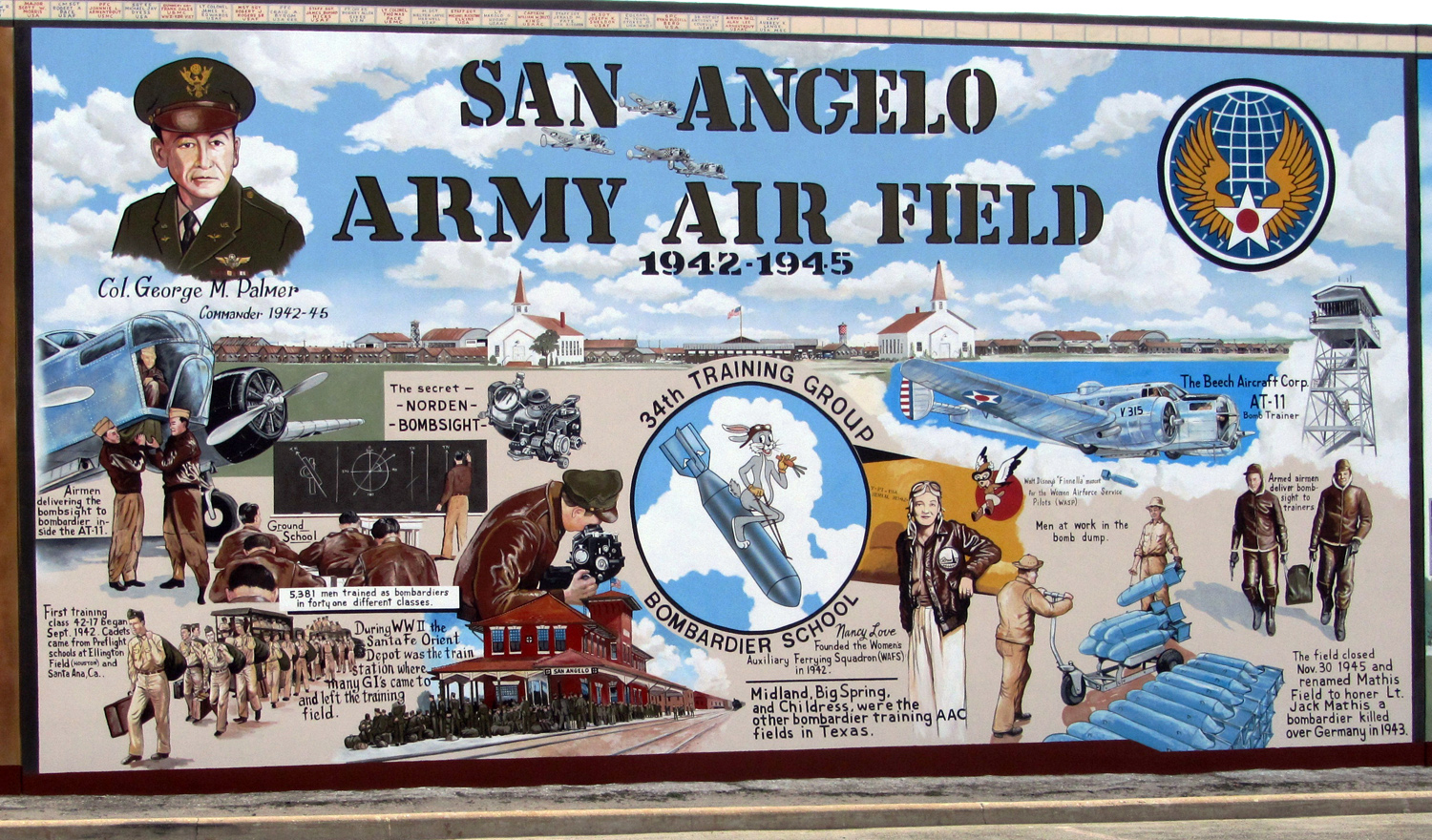|
The Military Mural
Our main project for 2012 was the Military Mural, located at 108 E. Concho in downtown San Angelo. Three different themed panels make up the entirety of the Military Mural-Fort Concho, San Angelo Army Air Field, and Goodfellow Air Force Base. We hope you enjoy viewing, reading, and hearing about the military history of our town.
Military Mural: Fort Concho

Fort Concho was established as a United States Army post in November 1867 with five companies of the Fourth Cavalry. It replaced Fort Chadbourne, which was closed the same year due to a chronic shortage of water. The new post was first named Camp Hatch and then Camp Kelly. In March 1868, it was named Fort Concho after the Middle and North Concho rivers, which converge in San Angelo to form the Concho River. During its 22-year existence as an active Army post, Fort Concho mainly served to maintain trade routes and to protect frontier settlers, stagecoaches, wagon trains and the U.S. Mail.
Fort Concho was home to both cavalry and infantry, and 50 percent of the enlisted soldiers were black. The Indians called them "buffalo soldiers" because of the color and texture of their hair. Two of the commanders are pictured in the mural. Col. Ronald MacKenzie was appointed colonel of the 24th U.S. Infantry regiment in 1867. He is considered by many as the dominant figure in the history of Fort Concho. Due to a previous battle wound that cost him the first two fingers of his right hand, the Comanche nicknamed him "Bad Hand." Col. Benjamin Grierson commanded Fort Concho's regimental headquarters for the 10th U.S. Cavalry, known as the Buffalo Soldiers, from 1875-1882. Their Coat of Arms is painted between the two mounted soldiers.
Three well-known Indian chiefs are included in this mural as testament to their leadership roles in trying to thwart the westward push of the settlers. Lone Wolf was a principal chief of the Kiowa and led fierce raids into Texas in the early 1870s in reaction to massive encroachment on their lands and the slaughtering of huge buffalo herds. Victorio was a warrior and chief of the Chiricahua Apache in what is now New Mexico. He was a marauder and was chased across Texas and New Mexico for years before finally being surrounded and killed in October 1880 by Col. Joaquin Terrazas, noted Indian fighter and leader of the Chihuahua state militia. Quanah Parker was a Comanche chief and a leader in the Native American Church. He was also the last leader of the powerful Quahadi band before they surrendered in the Battle of the Great Plains and went to a reservation in Indian Territory in 1875. He was the son of Comanche Chief Peta Nocona and Cynthia Ann Parker, kidnapped daughter of Silas M. Parker, one of the founders of Fort Parker. Cynthia and her brother, John, were captured and their father was killed when the Caddo and Comanche Indians attacked and overran Fort Parker on May 19, 1836. She was about nine years old.
The handgun pictured is the Army model 1873 Colt .45 single-action revolver known as the "Peacemaker." This six-shooter was usually issued to the mounted cavalry soldiers, and it made a huge difference in their fighting effectiveness. The Peacemaker became the standard sidearm of the postwar military, the Texas Rangers, and the majority of cowboys across the plains.
The model 1873 "Trapdoor" Springfield was the first standard-issue breech-loading rifle adopted by the U.S. Army. It shot a .45-caliber lead bullet backed by 70 grains of black powder. This was a powerful weapon, but was also prone to the spent cartridge jamming in the breech during rapid-fire conditions.
Fort Concho's cannon is also represented in the mural, though artillery was often of limited use in fighting the Indians. The rough West Texas terrain coupled with the elusive fighting style of the Indians made a heavy piece of ordnance difficult to use effectively during battle situations. More commonly, the cannons were used in post ceremonies, like the morning and evening salute.
Military Mural: San Angelo Army Air Field

Construction of Carr Field Municipal Airport near Lake Nasworthy began in 1940, but was not yet completed by the time the Japanese attacked Pearl Harbor in December 1941. San Angelo immediately began successful negotiations with the military to convert the airfield into an Army Air Forces bombardier training base. Military construction crews took over the job of completing the airport in May 1942.
The San Angelo Army Air Field was activated on June 1, 1942, under the jurisdiction of the Army Air Forces Training Command. The hangars, barracks, warehouses, hospitals, dental clinics, dining halls, chapels and maintenance shops represented in this mural were mostly constructed of wood, concrete, brick and gypsum board. A modified 20th Army Air Forces emblem is painted in the upper-right corner of the mural.
The buildings took some months to finish, so it wasn't until Jan. 8, 1943, that the 34th Flying Training Wing and the San Angelo Army Air Field Bombardier Training School were activated. The training school emblem, featuring the Warner Brothers' Bugs Bunny character riding astraddle a bomb, and the Army Air Force AT-11 advanced twin-engine training aircraft are featured in this mural. Col. George Palmer, the commander through the entire bombardier training period, and the Bugs Bunny logo are painted as they appear in the graduation program for the first class of bombardier graduates from the San Angelo school, Class 42-17. Records show that 5,381 men were trained here to be bombardiers.
Bombardier trainees received about 35 flying hours of certification training with the Top Secret Norden bombsight. They practiced dropping at least 20 of the M38A2 inert 100-pound bombs per month, averaging about 200 practice bombs during their 260 total hours of training over the 12-to-18-week course.
This mural shows the cadets arriving and departing at the Santa Fe Train Depot, studying in ground school classes, loading and unloading the bombsight from the aircraft, and aiming through the Norden eyepiece. The mural also depicts how the classified bombsight may have been secured to and from the aircraft by crewmembers under arms.
There was already a shortage of pilots by the fall of 1942, so the Army Air Forces directed aviator Nancy Harkness Love to recruit women to ferry planes for the Air Transport Command. Twenty-five thousand women applied for the Women's Auxiliary Ferrying Squadron program and more than 1,100 women aviators flew every aircraft the USAAF had, including trainers, cargo planes, pursuers and bombers. Love is featured in this mural leaning against a transport aircraft with the Women Air Force Service Pilots logo featuring the Walt Disney gremlin, Fifinella, painted above her left shoulder.
Soon after the end of WWII on Nov. 30, 1945, the flag over San Angelo Army Air Field was lowered for the last time. City officials eventually worked out a transfer deal that allowed them to reclaim the original Carr Field acreage, as well as almost all of the government-built buildings and airfield improvements. During this transition, the city renamed the airfield Mathis Field in honor of Lt. Jack Mathis, a bombardier who received the Medal of Honor posthumously for heroic actions during a mission over Germany in March 1943.
Military Mural: Goodfellow Air Force Base

There was a word or an acronym that pilots used to use to describe this kind of area: CAVU, they called it, or Ceiling And Visibility Unlimited. That's much of the reason Goodfellow Air Force Base is here. With so few mountains and clouds it was a great place to train folks to fly.
The rest of the reason Goodfellow is here has to do with the people of San Angelo and the special relationship they forged with the base. That relationship has been there from the very beginning. When the city, upon discovering the U.S. Military wanted to build a pilot training base in Texas, volunteered to put up the land and utility tie-ins so the base could be built here. That was back in 1940, more than a year and a half before the attack on Pearl Harbor. The history that unfolded over the next seven decades has captured wonderfully in this magnificent mural.
In the center is the image of Lieutenant John Goodfellow for whom the base is named. Lieutenant Goodfellow was a native of San Angelo and a World War I aviator who was killed in action while flying a deep reconnaissance mission behind enemy lines over France in September 1918.
Probably the next image or images to catch your eye are the wonderful, colorful airplanes. These were trainers, which makes perfect sense since Goodfellow started out as a pilot training base. On the left, the blue and yellow BT13 was nicknamed "The Vibrator" because of the effect it had on the pilots and the students who flew it. Next is the stunningly yellow T6 Texan, painted that way to make it easy to see and avoid. And there was the training version of the B-25 Medium Bomber used in the multi-engine training program at Goodfellow and the last trainer to be used at the base. That was because pilot training at Goodfellow came to an end in September 1958 when the base converted to an intelligence training-or as they say today, ISR training-"Intelligence, Surveillance, and Reconnaissance."
The mural is rich in images relating to the ISR mission. At the bottom of the mural, left of center, three images feature cryptological linguistic training, which used to be called "imagery training" and "general intelligence training." And then on the right side is the image of antennas and four linguist students seated at consoles. Notice their uniforms-Marine, Army, Air Force, Navy. That's because Goodfellow provides ISR training for all the services.
Now look at the picture beneath the linguists. The aircraft is engulfed in flames, but it's not on fire, and it's not an accident. It's part of Goodfellow's fire training mission using clean propane to train firefighters once again for all the services.
Below the image of Lieutenant Goodfellow are six emblems, each representing a different period in the history of the base. The current emblem-the yellow shield on the right-belongs to the Seventeenth Training Wing, the host unit of the base since 1993. The Seventeenth has a long and storied history that includes the famous Doolittle raid of World War II, night-time interdiction missions in Korea, B-52 missions over Vietnam, and the U2 reconnaissance missions as part of Desert Storm.
Finally, at the bottom of the mural towards the center, are the images of Pave Paws and A.I.C. Elizabeth Jacobson. Pave Paws was a radar site near Eldorado, Texas, that watched for submarines and their launch ballistic missiles coming in from the Gulf. Goodfellow provided logistic support for the radar site until it closed in the mid-1990s. Airman Jacobson, as the mural explains, was a Security Forces member of the Goodfellow team killed in action in Iraq in 2005. The main entrance of the base has been named in her honor.
|





